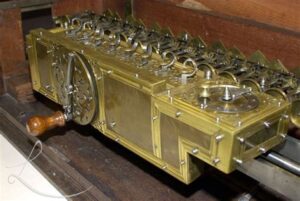Back to: Computer Studies JSS1
Welcome to class again!
In today’s class, we shall continue talking about what we started on electro-mechanical counting devices. Please enjoy the class!
Electro-Mechanical Counting Devices (continued)
Building on the foundations of mechanical counting devices, electro-mechanical devices introduced the integration of electrical components into the counting process
Leibniz Machine

Gottfried Leibniz, a German mathematician and philosopher, developed his own mechanical calculator in 1671, known as the Leibniz machine.
Building upon Pascal’s design, the Leibniz machine introduced the concept of a stepped reckoner, which allowed for direct multiplication and division.
The Leibniz machine’s capabilities expanded the range of mathematical operations that could be performed mechanically.
Joseph Jacquard Loom

While not specifically designed for counting, the Joseph Jacquard loom, invented in 1801, demonstrated the potential of automated control using punched cards.
Jacquard’s loom used a series of punched cards to control the weaving pattern, automating a previously manual process.
The concept of punched cards would later become integral to the development of early computers.
English mathematician Charles Babbage is credited with designing two groundbreaking mechanical computing devices: the Difference Engine and the Analytical Engine.
The Difference Engine, designed in 1819, was intended to calculate and print mathematical tables, particularly logarithms and navigational tables.
The Analytical Engine, conceptualized in 1833, was a more versatile machine that could perform a wider range of mathematical operations and was considered the first general-purpose computer.
While neither of Babbage’s engines were fully constructed during his lifetime, their designs laid the foundation for the development of modern computers.
Electro-mechanical counting devices played a crucial role in the advancement of mathematics, engineering, and science.
They provided more efficient and accurate methods for performing complex calculations, enabling scientific breakthroughs and technological innovations.
The development of these devices laid the groundwork for the creation of electronic computers, which revolutionized computing and transformed society.
In conclusion, electro-mechanical counting devices marked a significant transition in the history of computing, bridging the gap between mechanical and electronic machines. Their contributions to mathematics, science, and technology are undeniable, paving the way for the modern computing age.
We have come to the end of today’s class. I hope you enjoyed the class!
In the next class, we shall be discussing the hollerith census machine.
In case you require further assistance or have any questions, feel free to ask in the comment section below, and trust us to respond as soon as possible. Cheers!
Question Time:
- What is an electro-mechanical counting device?
- What are some examples of electro-mechanical counting devices?
- How did electro-mechanical counting devices impact the development of computers?
- What are some of the limitations of electro-mechanical counting devices?
- How did electro-mechanical counting devices contribute to scientific and technological advancements?
